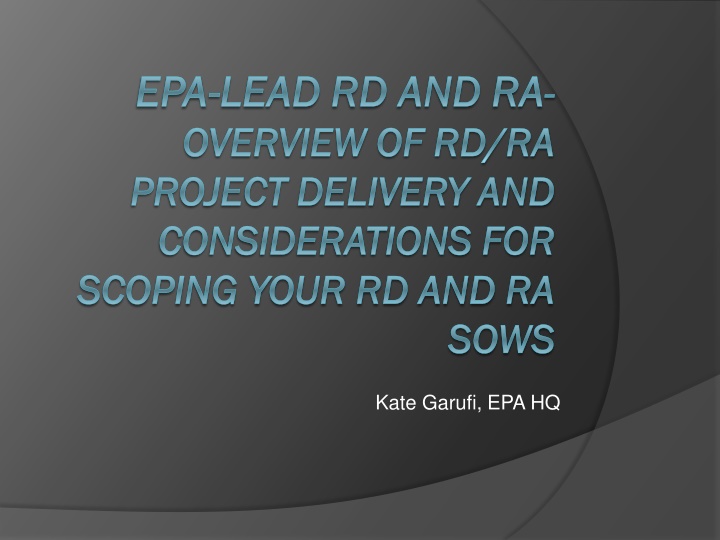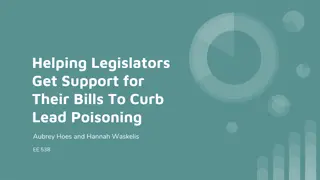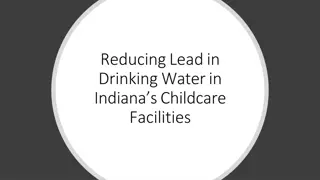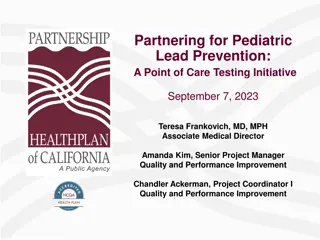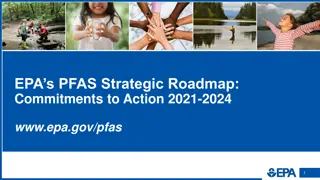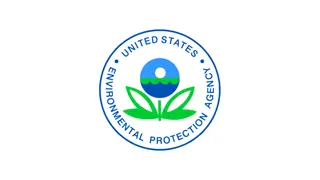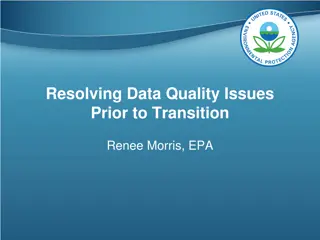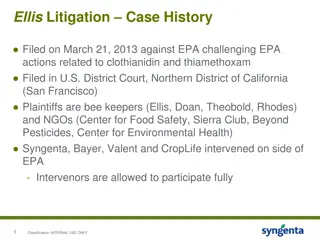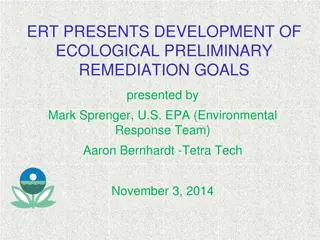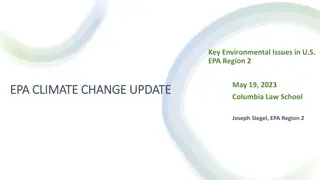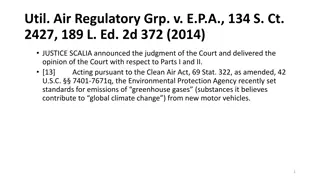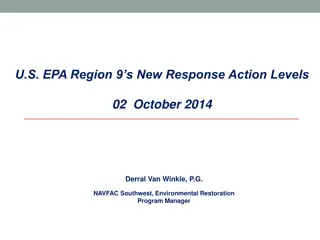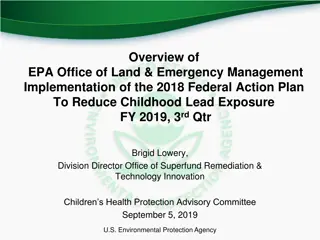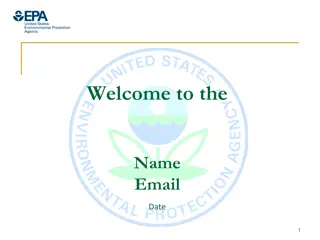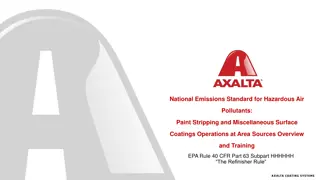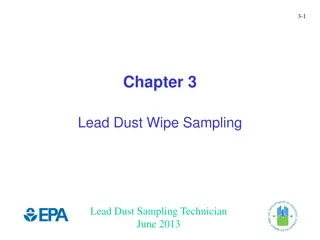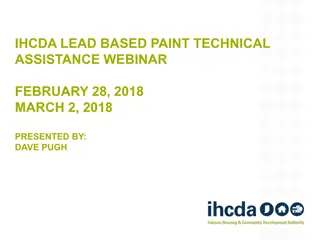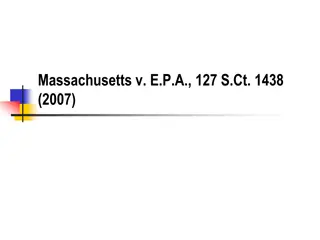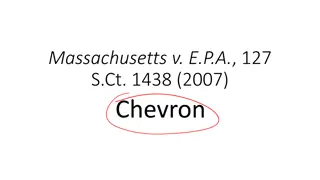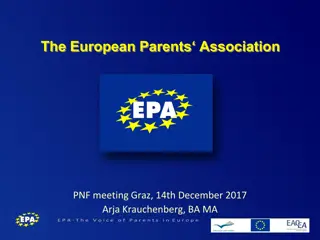Overview of EPA Lead RD and RA Project Delivery Considerations
This presentation discusses the importance of considering project delivery early in the scoping process of EPA-led Remedial Design and Remedial Action projects. It aims to change the paradigm for scoping projects, focusing on big-picture considerations and providing examples of project delivery and statement of work development considerations.
Download Presentation

Please find below an Image/Link to download the presentation.
The content on the website is provided AS IS for your information and personal use only. It may not be sold, licensed, or shared on other websites without obtaining consent from the author.If you encounter any issues during the download, it is possible that the publisher has removed the file from their server.
You are allowed to download the files provided on this website for personal or commercial use, subject to the condition that they are used lawfully. All files are the property of their respective owners.
The content on the website is provided AS IS for your information and personal use only. It may not be sold, licensed, or shared on other websites without obtaining consent from the author.
E N D
Presentation Transcript
EPA EPA- -LEAD RD AND RA LEAD RD AND RA- - OVERVIEW OF RD/RA OVERVIEW OF RD/RA PROJECT DELIVERY AND PROJECT DELIVERY AND CONSIDERATIONS FOR CONSIDERATIONS FOR SCOPING YOUR RD AND RA SCOPING YOUR RD AND RA SOWS SOWS Kate Garufi, EPA HQ
Purpose Focus on EPA-lead RD/RA projects Communicate the importance of considering RD/RA project delivery early in the RD scoping process Change the stovepipe paradigm for scoping EPA-lead RD and RA projects Discuss big picture considerations when developing your RD and RA SOW Discuss 3 RD/RA examples Project delivery considerations SOW development considerations 2
Outline Overview of the Remedial Acquisition Framework RD/RA Project Delivery Strategy Statement of Work Overview Developing the RD SOW Developing the RA SOW Examples 3
Overview of the remedial Overview of the remedial acquisition framework acquisition framework 4
Existing Contracts Superfund RD and RA services delivered primarily through: Interagency Agreements; Cooperative Agreements; or EPA Remedial Action Contracts (RACs) RACs provide cradle to grave support for the remedial program Direct RD support Subcontract RA 5
Remedial Action Contracts Regionally awarded and administered Single solicitation/single award contracts At least two per Region Work Assignment (WA) or Task Order (TO) ID/IQ Contracts TO/WA Process Generally Cost reimbursable No competition between RAC firms 6
Remedial Acquisition Framework EPA contracts will not longer be cradle to grave contracts Separate design and remedial action activities Design/bid/build EPA contracts Design and Engineering Services (DES); Remediation Environmental Services (RES); and Environmental Services and Operations (ESO) EPA may still leverage other Federal Agencies and States through IAs and CAs 7
Major Changes that Impact RPM role (and SOW development) National Contracts Competition at the task order level Direct contracting for remedial action EPA CONTRACTING PARTY - RPM - Contracting Officer RA Contractor Constructor Construction Superintendent On-Site Rep 8
Additional information on RAF The revised Sources Sought/Request for Information (SS/RFI) has been posted to Fed Connect and Fed Biz Opps. https://www.fbo.gov/index?s=opportunity&mode=form&i d=65baba2015ea27c769ad82435b941d0e&tab=core &_cview The posting invites vendors to review documents at the OAM web link: http://www.epa.gov/oamreg01/region3/SOL-R3-13- 00006/index.htm Final Remedial Acquisition Framework document is still in draft. Expected to be released in Spring 2014. 9
Questions? Questions? 10
RD/RA project delivery RD/RA project delivery strategy strategy 11
What is a RD/RA Project Delivery Strategy? Strategy includes decisions regarding: Design type (detail of specifications) Remedial action contracting strategy Procurement approach Remedial action contract type MUST be discussed and considered early when scoping the design 12
Role of RPM in the Project Delivery Strategy RPM can influence all components of the RD/RA project delivery strategy Now that EPA is moving towards directly contracting for remedial action services, RPM involvement is scoping project delivery early in the design in critical Communication with contractors on design schedule and funding constraints/requirements Communication with HQ on RA funding needs (timing and dollars) Communication with EPA contracting office (type of RA contract, timing of award, etc) Communication with design contractor on phasing project components, if needed 13
Why is Design Type Important for Delivery of a Remedial Action? The type of remedial action contract vehicle should have an impact on the types of design specifications needed Specifications are an integral part of the remedial action contracting package Specifications describe the technical requirements to be met by the RA contractor and the criteria for determining whether these requirements have been met. All three components (design specifications, procurement method and contract type) should be considered BEFORE the design requirements are scoped 14
Remedial Design The purpose of the design is to provide technical requirements (plans and specifications) that provide an adequate level of information needed for the remedial action contractors to provide technical approach (with labor/skill mix) and cost proposals In general, the design is the basis for the statement of work for the remedial action. 15
Types Remedial Design Specifications Detailed (Prescriptive) Outline exactly how the remedial action contractor should perform the activities Performance-based Focus on outcomes or results rather than a process 16
What type of specifications are Superfund remedial designs? Superfund remedial designs generally include a combination of detailed specification and performance-based specifications This is due to some requirements that must be met related to: Government regulations on procurement with Federal dollars; Environmental/construction standards; or Environmental regulations (ARARs) 17
Remedial Action Contracting Strategy Procurement Approach Sealed bid Two-step sealed bid Negotiated Remedial Action Contract Type Firm Fixed Price Fixed Rate Const Reimbursable Time and Materials 18
What RA contracting strategy is right for my project? It depends!!! When scoping the design, keep the end in mind. RA delivery considerations that may directly impact the design: Certainty of the site characterization Site complexity Management effort Financial risk (EPA and contractor) Cost Control In general, a detailed design will be done at some point in the RD/RA process it is your decision on where it is done: RD contractor RA contractor 19
Relationship Between Site Characterization Certainty and Cost Cost Increasing Certainty Increasing 20
Matching Site Type to Appropriate Contracting Strategy Determine level of certainty associated with site characterization High certainty = less flexible strategy Low certainty = more flexible strategy Determine the complexity of the site and the remedial action Simple = less flexible strategy Complex = more flexible strategy 21
Considering Management Effort Less Flexible Strategy Less Management Effort More Management Effort More Flexible Strategy 22
Considering Financial Risk Borne primarily by the contractor Fixed price contracts Shared by contractor and government Time and material contracts Borne primarily by the government Cost reimbursement contracts Less certain site characterization and increased site complexity require government to share financial risk 23
Considering Cost Control Less Flexible Strategy More Cost Control Less Cost Control More Flexible Strategy 24
How on earth do I track all of this stuff?? Use a project risk register! 25
Questions? Questions? 26
Statement of work overview Statement of work overview 27
What is a Statement of Work Definition: Description of the specific service or tasks a contractor is required to perform under a contract This presentation and the examples will focus on the development of a task order SOW for either RD or RA 28
Why is the SOW so important? The SOW is the pivotal acquisition document for goods or services The SOW is the key factor to determine the task order type; OR the SOW should comport with desire task order type Key document for contactor preparation of cost and technical proposals 29
Why is the SOW so important? Facilitates proposal negotiations and competition, as appropriate Establishes conclusive baseline to evaluate proposals; and Establishes the standards to which you can gauge the contractor s performance 30
Different types of SOWs Prescriptive Performance-based 31
Prescriptive SOW Requirements are described in terms of processes or tasks Government instructs the contactor when, where, and how In general, does not address desired end result Change in scope requires modification to the contract document 32
Performance-Based SOW Requirements described in terms of end result (measurable outcome) versus how to get there Provides a basic, top level objective(s) of the acquisition Enable assessment of work performance against measurable performance standards Contractor provides labor mix and skill set solutions to fulfill the requirement Used when the Government intends to provide maximum flexibility to each offeror to propose an innovative approach Change is scope and adjustments to the process without modification as long as goals are met 33
Developing the remedial Developing the remedial design statement of work design statement of work 34
Scoping the RD SOW The information contained in the RI/FS, ROD and any subsequent investigation activities should serve as the initial building block for developing the RD SOW Identify remedial action objectives, cleanup levels Identify technologies and level of detail under which the remedy is described Identify level of site characterization conducted during the RI/FS 35
Developing the RD SOW Five key remedy implementation items that should be included in the SOW: The treatment system or technology; Performance standards; Any points of compliance; How to demonstrate compliance/completion; and Schedule 36
Developing the RD SOW In general, the SOW for executing the remedial design is considered performance-based. Strongly encouraged that EPA has a scoping meeting with the contractor after award to discuss RD/RA project delivery strategy The type of design specifications (prescriptive versus performance-based) must be understood by all stakeholders before the design work begins 37
RD SOW Best Management Practices Include your technical team in the scoping of the RD! Write the SOW with enough flexibility to allow for changes to the contractor work plan without modifications to the SOW or task order document Keep a risk register. Track assumptions made during the RI/FS, ROD and the RD scoping meeting. As data is collected and design proceeds, additional information may require a change to the RD/RA project delivery strategy. 38
Two RD delivery methods EPA contracts directly with the designer EPA contractor USACE, State, or Tribe does work in house EPA does not contract directly with the designer USACE contracts with designer State/Tribe contracts with designer 39
EPA contracts directly with the designer EPA CONTRACTING PARTY - RPM - Contracting Officer Design Contractor Design Engineer 40
RD SOW components for EPA contracts Introduction (5 musts!) General Requirements Schedule Project Planning and Support Site-specific plans Community Relations Pre-design investigation Data Acquisition Sample Analysis Data Evaluation and Support Treatability Study Design Deliverables Preliminary/Intermediate/Prefinal and Final Post Remedial Design Support 41
EPA does not contract directly with the designer EPA Contracting Party: USACE State/Tribe RD Subcontractor Design Engineer 42
RD SOW components for IAs and CAs Introduction (5 musts!) General Requirements Schedule Site specific plans Reporting Pre-design Investigation Procurement of RD subcontract Subcontract management support Contractor oversight and reporting Project Closeout 43
Considerations when scoping the RD SOW for IAs and CAs The USACE or State/Tribe will develop the SOW for the design contractor Important that the RPM discusses the planned project delivery with the USACE or State/Tribe prior to developing the design Critical to ensuring deliverables comport with contracting strategy (and available funding) Want to avoid any need for re-design (or deliverables not used) by the entity procuring the remedial action contract! 44
Questions? Questions? 45
Developing the remedial Developing the remedial action statement of work action statement of work 46
Scoping the RA SOW The technical plans and specifications should drive the content of the RA SOW Develop SOW objectives that comport with design and account for uncertainties The 100% design should be reviewed to determine: Detail of design specifications Points of compliance/completion Schedule Any project phasing (if applicable) 47
Developing the RA SOW The objectives of the SOW should match the detail in the design For an SOW with detailed design specifications, the RA SOW should focus on implementing the design. Any changes will result in a change to the design and the RA SOW. For an SOW with a more performance-based design, the RA SOW should focus on the end goal and metrics to evaluate progress and completion of the task Problems with performance-based SOW and a detailed design Detailed design instructs know your site complexities and uncertainties Performance objectives may not be met by detailed design if site conditions or assumptions made during the design change May require design/SOW changes during the RA 48
RA SOW Best Management Practices Consider planned remedial action contracting strategy (procurement approach and contract type) when writing the SOW Understand site assumptions and uncertainties Revisit and update the risk register and evaluate assumptions made in design Evaluate likelihood of changing site conditions Ensure contract allows for these changes (should they occur and they often do!) RA contactors understand environmental remediation and risk if RD/RA contracting strategy provides for a high degree of contractor financial risk, contracts will: Account for risk in cost proposal; or May not bid on a project 49
Two delivery methods EPA contracts directly with the remedial action contractor EPA does not contract directly with the designer 50
